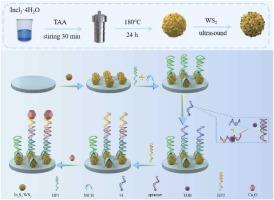Construction of a self-powered and polarity switched photoelectrochemical biosensor based on In2S3/WS2 for the detection of tobramycin
IF 3.7
1区 化学
Q1 CHEMISTRY, ANALYTICAL
引用次数: 0
Abstract
This paper presents a self-powered ultrasensitive photoelectrochemical (PEC) biosensor for the detection of tobramycin (TOB), establishing a highly selective detection platform through photocurrent polarity switching. Utilizing the principle of electrostatic adsorption, WS2 is uniformly loaded onto the loose and porous surface of In2S3. The synthesized composite (In2S3/WS2) features a large specific surface area, enhancing light absorption and increasing solid-liquid interfacial contact, thereby promoting the separation of photogenerated carriers and interfacial reactions. Due to the energy level alignment between In2S3 and WS2, the In2S3/WS2 composite can generate photocurrent signals of up to 130 μA at 0 V under visible light irradiation. Cu2O is synthesised on indium tin oxide (ITO) electrodes lidded with the In2S3/WS2 composite via Cu-S bonding, serving as a signaling label for the polarity reversal mechanism of the PEC biosensor. Thanks to the remarkable photovoltaic performance of In2S3/WS2 and the reliability of Cu2O photocurrent polarity switching, the designed TOB biosensor exhibits a detection range from 1.0 pg/mL to 10 µg/mL with a limit of detection of 0.33 pg/mL (S/N = 3). By substituting the aptamer, the PEC biosensors developed in this study also have potential for widespread application in detecting other analytes, playing a vital role in bioanalysis and food safety.

基于In2S3/WS2的自供电极性开关光电化学生物传感器的构建及妥布霉素检测
提出了一种用于妥布霉素(tobramycin, TOB)检测的自供电超灵敏光电化学(PEC)生物传感器,通过光电流极性开关建立了一个高选择性的检测平台。利用静电吸附原理,将WS2均匀地吸附在In2S3的疏松多孔表面。合成的复合材料(In2S3/WS2)具有较大的比表面积,增强了光吸收,增加了固液界面接触,从而促进了光生载流子和界面反应的分离。由于In2S3和WS2的能级对准,在可见光照射下,In2S3/WS2复合材料在0 V下可产生高达130 μA的光电流信号。Cu2O通过Cu-S键合在In2S3/WS2复合材料覆盖的氧化铟锡(ITO)电极上合成,作为PEC生物传感器极性反转机制的信号标记。基于In2S3/WS2优异的光伏性能和Cu2O光电流极性切换的可靠性,设计的TOB生物传感器检测范围为1.0 pg/mL ~ 10µg/mL,检测限为0.33 pg/mL (S/N=3)。通过取代适体,本研究开发的PEC生物传感器在检测其他分析物方面也有广泛应用的潜力,在生物分析和食品安全方面发挥着重要作用。
本文章由计算机程序翻译,如有差异,请以英文原文为准。
求助全文
约1分钟内获得全文
求助全文
来源期刊

Sensors and Actuators B: Chemical
工程技术-电化学
CiteScore
14.60
自引率
11.90%
发文量
1776
审稿时长
3.2 months
期刊介绍:
Sensors & Actuators, B: Chemical is an international journal focused on the research and development of chemical transducers. It covers chemical sensors and biosensors, chemical actuators, and analytical microsystems. The journal is interdisciplinary, aiming to publish original works showcasing substantial advancements beyond the current state of the art in these fields, with practical applicability to solving meaningful analytical problems. Review articles are accepted by invitation from an Editor of the journal.
 求助内容:
求助内容: 应助结果提醒方式:
应助结果提醒方式:


